Matador Network's Blog, page 86
December 16, 2024
To Spur Winter Tourism, a Mountain Town Made a Hilarious Christmas Movie Spoof

We all know the format: a woman who moved to the big city returns to her small town — probably with the goal of developing land, closing down small businesses, or otherwise changing it for the worse — only to reconnect with a man she knew from her childhood. Without fail, the two fall in love, the woman from the big city comes to appreciate the charms of the small town, and the two work together to save the town/farm/business, etc.
It’s a tried-and-true format for holiday movies from companies like Hallmark and Netflix, with titles like Small Town Christmas, Christmas with You, and Return to Christmas Creek. Sure, movies will occasionally break the mold — Hot Frosty, for example, tells the story of a young widow bringing a sexy snowman to life — but on the whole, it’s such a cliched plot that you’ll find thousands of social media videos online making fun of the trope.

Photo: Visit Carson City
And this year, one tourism board also decided to get in on the action. Carson City, Nevada, just released a hilarious Christmas video spoof in the genre, designed to convince people to visit the Sierra Nevada town this winter. A Winter’s Charm in Carson City nails the story line, complete with fake shots of a roaring fireplace, a generic hunk forlornly looking over his shoulder at the “big city girl,” cheesy winks to the camera, a true “meet cute,” and montages of the two falling in love over selfies and ice cream.
According to Visit Carson City, the local tourism board that made the movie, its “cheeky storyline checks all the boxes with plenty of holiday romance tropes,” including a “cookie-cutter plot line.” It’s meant to be a funny Christmas movie spoof, but also designed to show off the winter experiences available in Carson City, which sits about 15 miles east of Lake Tahoe in the Sierra Nevada Mountains. In the movie, the two just so happen to visit destinations like the twinkle-light-covered Governors Mansion, sprawling networks of hiking trails, a historic railroad museum, and local restaurants with outdoor fire pits.
It’s hilariously on the nose when it comes to parody, with the main character simply saying she lives in “Big City” and a generic park ranger who keeps turning to the camera and pitching Carson City tourism as the other characters look awkward and confused. Naturally, the movie ends with the two deciding to stay together forever in Carson City, complete with whipped-cream-topped hot chocolates appearing seemingly out of nowhere.

Photo: Visit Carson City
Carson City is the capital of Nevada and sits about 10 miles south of Reno, home to Reno-Tahoe International Airport. Close to Carson City are attractions like Virginia City (a former mining town loaded with old-timey bars and historic shops and museums), as well as Lake Tahoe and historic resorts like Carson City Hot Springs and Hope Valley. It’s also close to Genoa, home to the oldest bar in the state, and offers easy access to both a growing Basque food scene in Carson, and a growing celebrity chef food scene in Reno. 
Whether You’re in Cleveland for a Game or a Getaway, These Are the Best Airbnbs in the City

Cleveland, Ohio, is undergoing a renaissance. Once an industrial powerhouse, the city has transformed itself and is no long only drawing sports fans. With its cool neighborhoods, excellent museums, and burgeoning food scene, Cleveland offers something for everyone. Whether you’re a history buff, into rock and roll, a foodie, an art lover, or you’re looking for a destination for a reunion or bachelorette, you’re sure to find your niche here. It’s also one of the best cities in the US to explore on foot, so don’t get too hung up on what area to base yourself. That said, if you want to be in the heart of the action, Downtown is the best choice. For a more laid-back experience, Ohio City or Tremont are great options. Here we have gathered some of the best Airbnbs in Cleveland for those looking for a one bedroom studio or apartment, and large options more suitable for families and groups.
We hope you love the Airbnb Cleveland rentals we recommend! Just so you know, Matador may collect a small commission from the links on this page if you decide to book a stay. Listed prices are accurate as of the time of publication.
The best Airbnbs in Cleveland for solo travelers and couplesUrban cottage in the heart of Tremont Photo: Airbnb
Photo: Airbnb Photo: Airbnb
Photo: Airbnb Photo: Airbnb
Photo: Airbnb Photo: AirbnbSee more photos
Photo: AirbnbSee more photosSituated just north of Tremont, you can’t beat this location if you want to be able to walk to everything. And by everything, I mean cafes, fine dining, tasting rooms, live music venues, boutiques, art galleries, libraries, metro park trails, a rock climbing gym — you name it. The rental is located behind a local coffee shop and is a small cottage sized property with an urban vibe (think exposed brick walls and splashes of modern art.) It comes with off street parking, which is a huge bonus if you’re driving in and the outdoor space is fenced in. The one bedroom has a memory foam mattress and the bathroom is modern with a block steam shower and heated towel rails.
Two guests, one bedroom
Price: $123 per night
 Photo: Airbnb
Photo: Airbnb Photo: Airbnb
Photo: Airbnb Photo: Airbnb
Photo: Airbnb Photo: AirbnbSee more photos
Photo: AirbnbSee more photosThis property is within Airbnbs top ten percent category. This award system came into play earlier this year and helps users navigate listings by easily seeing those that have a long standing history of excellent past guest reviews. The brand new apartment is located in The Stepp House, a landmark building in the Superior Arts Historical District of greater downtown. It’s a find for those coming into town to see a game as it’s just over a mile to Browns Stadium and the Progressive Field.
Two guests, one bedroom
Price: $83 per night
 Photo: Airbnb
Photo: Airbnb Photo: Airbnb
Photo: Airbnb Photo: Airbnb
Photo: Airbnb Photo: AirbnbSee more photos
Photo: AirbnbSee more photosIf you’d like a little more space and you’re traveling with a pet, this one is for you. It’s also a 10 percent listing and has an unbeatable location between Ohio City and Gordon Square. Past guests rave about the cozy ambiance and thoughtful details throughout the property. It’s situated on a quiet tree-lined street, and there’s easy free parking in front of the home and a tufted, fenced-in yard. If you’re visiting in summer, there’s an outdoor furnished patio with a hammock, fire pit, BBQ, and cornhole set. And, if you’re in town to visit Mason’s Creamery — a must — it’s only a block away.
Four guests, two bedrooms
Price: $145 per night
 Photo: Airbnb
Photo: Airbnb Photo: Airbnb
Photo: Airbnb Photo: Airbnb
Photo: Airbnb Photo: AirbnbSee more photos
Photo: AirbnbSee more photosI’ve also included a couple of options in Lakewood, just in case you’re on a road trip and would prefer to be outside the busy city center of Cleveland. Similar to Cleveland, Lakewood is very walkable. It’s a great place to base yourself in summer, with Edgewater Park and the beach nearby. Cleveland is a little under six miles away, so you can nip in and out and return to your cozy Airbnb at the end of the day. This super stylish centrally-located suite is of hotel standard. There are all the amenities you’d expect from a hotel stay and secure parking.
Four guests, two bedrooms
Price: $121 per night
 Photo: Airbnb
Photo: Airbnb Photo: Airbnb
Photo: Airbnb Photo: Airbnb
Photo: Airbnb Photo: AirbnbSee more photos
Photo: AirbnbSee more photosThis two-bedroom home is surrounded by trees in the middle of Tremont. The host suggests getting your sneakers on because this neighborhood is changing fast. Gentrification has pushed some local businesses to the side streets, so getting off the main drag and exploring on foot is worth it. It’s also a good option if you don’t have a vehicle during your stay in Cleveland, as it’s very well connected to public transportation links. It’s a top-five percent listing. Past guests love the tasteful decor and helpful hosts Joy and Chris, who can help you out with recommendations on where to eat and what to do during your stay.
Three guests, one bedroom
Price: $88 per night
 Photo: Airbnb
Photo: Airbnb Photo: Airbnb
Photo: Airbnb Photo: Airbnb
Photo: Airbnb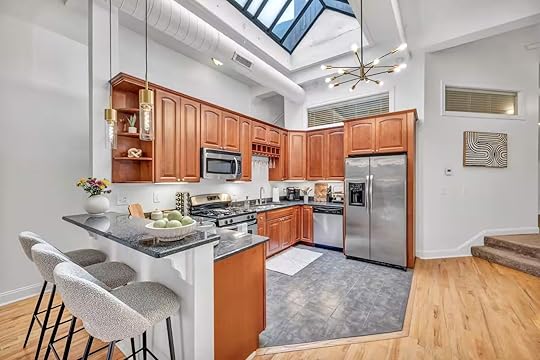 Photo: AirbnbSee more photos
Photo: AirbnbSee more photosIn the heart of downtown Cleveland, this stylish loft offers the perfect blend of comfort, convenience, and sophistication. The loft’s two cozy bedrooms, each equipped with a king-sized bed, offer a peaceful retreat after a day of exploring the city. The open-concept living area, complete with a comfortable sofa and a large flat-screen TV, is ideal for relaxing evenings and there’s a workspace in the master bedroom for those who need peace. The rooftop patio is the main selling point. You can enjoy breathtaking views of the Cleveland skyline while relaxing on comfortable seating or challenging friends to a game of cornhole.
Six guests, two bedrooms
Price: $184 per night
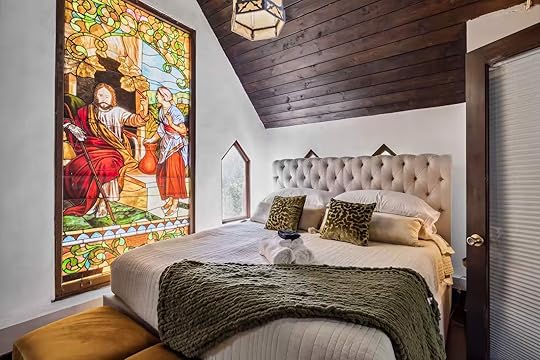 Photo: Airbnb
Photo: Airbnb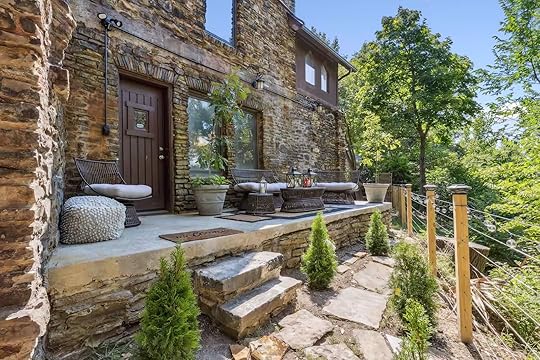 Photo: Airbnb
Photo: Airbnb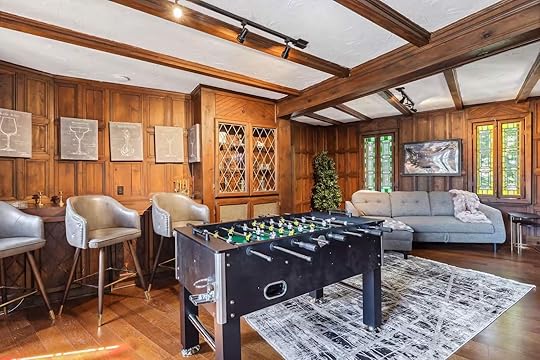 Photo: Airbnb
Photo: Airbnb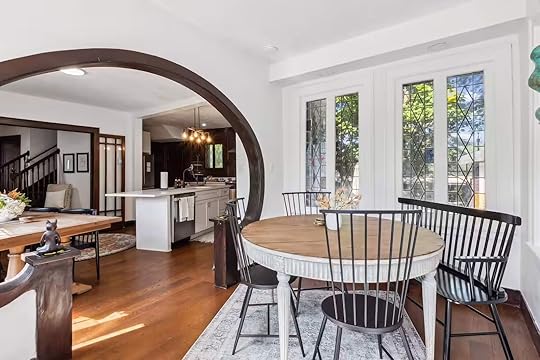 Photo: AirbnbSee more photos
Photo: AirbnbSee more photosOk, this one is a bit of a wild card, but I couldn’t resist. This castle — yes, you read that right — is located in the Old Brooklyn neighborhood, one of the most convenient spots for getting around all of great Cleveland. Downtown is a but ten minutes away by car, as are the trendy neighborhoods of Tremont and Ohio City. The 1920s castle has been beautifully restored with all the modern comforts and sleeps up to 11 — although, in true Airbnb fashion, there are only three bedrooms. If you’re looking for a place to remember, this is one to bookmark.
Nine guests, three bedrooms
Price: $178 per night
 Photo: Airbnb
Photo: Airbnb Photo: Airbnb
Photo: Airbnb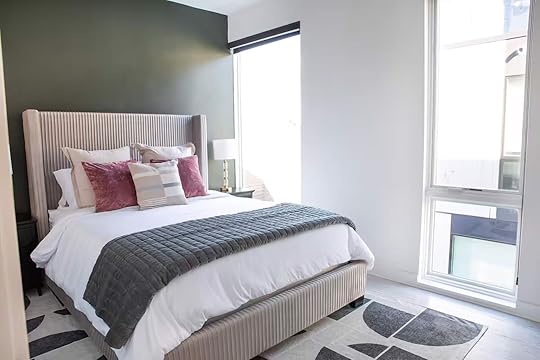 Photo: Airbnb
Photo: Airbnb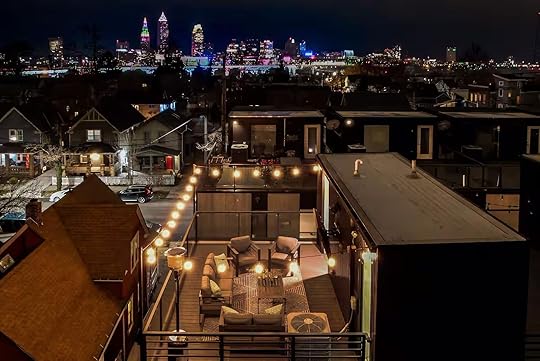 Photo: AirbnbSee more photos
Photo: AirbnbSee more photosAnother top-five percent listing is this property named Tremont Black, which is perfectly positioned in Tremont. The award-winning townhome is the perfect base for exploring the city. A short drive or ride-share will take you to a Guardians or Cavaliers game, Cleveland’s waterfront district, West Side Market, and a Broadway show or a live performance at Playhouse Square. The spacious, open-concept layout of the home is perfect for relaxing or entertaining guests, but the property’s highlight is undoubtedly the rooftop patio, which offers stunning views of the Cleveland skyline.
Six guests, two bedrooms
Price: $143 per night
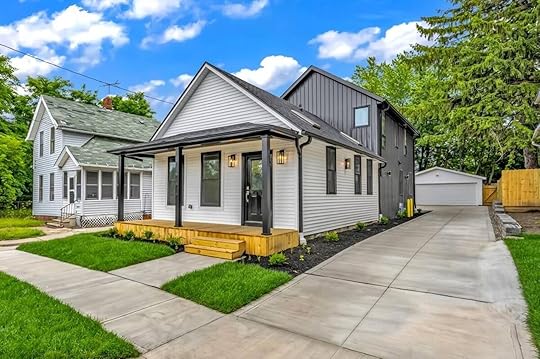 Photo: Airbnb
Photo: Airbnb Photo: Airbnb
Photo: Airbnb Photo: Airbnb
Photo: Airbnb Photo: AirbnbSee more photos
Photo: AirbnbSee more photosThis stylish and spacious three-bedroom home in the Detroit Shoreway neighborhood has a minimalist design and eco-friendly features that create a serene and sustainable atmosphere. The bedrooms offer comfortable bedding and plenty of storage space. The lower level provides additional sleeping accommodations, making it ideal for larger groups. Just a short walk from the house, you’ll find the West Side Market, a historic indoor-outdoor market selling fresh produce, meats, and artisanal goods. The market is a popular destination for locals and visitors, and it’s a great place to get to grips with Cleveland’s food scene. Nearby, you can also explore the Detroit Shoreway Greenways Trail, a scenic bike and walking path that winds through the neighborhood. The trail offers stunning views of Lake Erie and connects to other popular destinations, such as Edgewater Park and the Cleveland Metroparks.
10 guests, three bedrooms
Price: $222 per night
 Photo: Airbnb
Photo: Airbnb Photo: Airbnb
Photo: Airbnb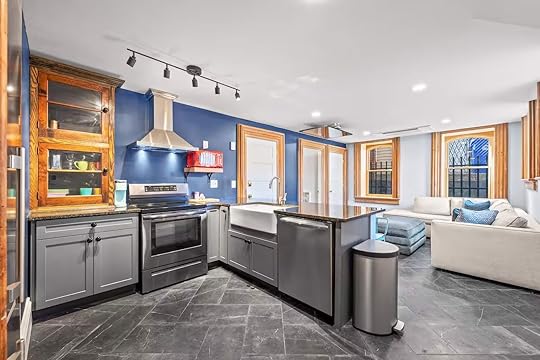 Photo: Airbnb
Photo: Airbnb Photo: AirbnbSee more photos
Photo: AirbnbSee more photosI listed this entry above, as within the property of The Stepp House, there are multiple rentals of different sizes. This option has four bedrooms and sleeps up to 12. As a professional company manages this listing and others, it’s an excellent option — expect all the bells and whistles. It’s also pet-friendly, which is quite hard to find in the city.
12 guests, four bedrooms
Price: $700 per night
 Photo: Airbnb
Photo: Airbnb Photo: Airbnb
Photo: Airbnb Photo: Airbnb
Photo: Airbnb Photo: AirbnbSee more photos
Photo: AirbnbSee more photosPerched dramatically above Lake Erie, this mid-century modern home, designed by renowned architect J. Byers Hays, offers a truly unforgettable stay in Lakewood. The home’s stunning architecture, combined with its prime waterfront location, is ideal for those looking to be close to Cleveland but would prefer a more low-key getaway. The home’s interior is a testament to Hays’ visionary design, featuring soaring ceilings, floor-to-ceiling windows, and a sleek, minimalist aesthetic. The open-concept living space is flooded with natural light, providing breathtaking lake views. The well-appointed kitchen is a chef’s dream, with modern appliances and ample counter space. The main suite has a stylish en-suite bathroom and stunning lake views, and the loft, accessible by ladder, provides additional sleeping space for guests. 
Six guests, two bedrooms
Price: $500 per night
Say Ciao to Overpriced Ski Vacations: Italy’s Ski Resorts Offer the Best Value in Europe

When I was young, and I would tell people my family were going skiing in Italy, and they would wrinkle their noses with snobbery. Italian skiing has a bad reputation in Europe. But I’m not sure where this attitude came from. Perhaps it’s because the region has been wrongfully labeled with the reputation of inconsistent snow conditions and poor runs. Overshadowed by the French Alps for too long, Italy’s upmarket snow resorts have been largely ignored, and that’s a huge mistake. Because not only do the runs in The Dolomites challenge those in France or Austria, but these destinations are a lot cheaper, especially if you’re doing a family ski or snowboard vacation. Last week, the British Post Office published a cost comparison report of European resorts and shared that Italy dominates, with six of its resorts in the top 10 places for skiing on the continent.
The Post Office’s annual report analyzes costs across 36 resorts, considering factors like lift passes, equipment rental, ski school, and on-slope dining. Using a “shopping basket” approach to calculate the average expenditure for a week-long adult ski trip, the organization took local prices from Crystal Ski Holidays to provide a standardized comparison across European destinations.

Bardonecchia, Italy. Photo: MikeDotta/Shutterstock
The results are undeniable: Italy reigns supreme. Six Italian resorts grace the top 10 for adult skiers, with Bardonecchia, situated in the Piedmont region near the French border, reclaiming the top spot for the second consecutive year. This picturesque village ticks all the boxes with affordability and accessibility to exceptional runs and an overall ski vacation experience. The village sits at an altitude of 1,312 meters, offering access to an impressive over 60 miles of pisted terrain, with the highest chair lift reaching 2,800 meters. It’s a family favorite, too. The center of Bardonecchia is pedestrianized, and there’s an ice rink, cinema, and sports center. The resort also offers discounted lift passes for kids, and there are so many options for ski schools offering both group and private lessons.
But Bardonecchia is just the tip of the Italian iceberg. Livigno, Sauze, Sestriere, La Thuile, and Cervinia all make the top 10, consistently outperforming their more established Alpine counterparts in terms of cost-effectiveness. These resorts also excel when it comes to family vacations. Passo Tonale tops the family chart, and Bardonecchia, La Thuile, Sestriere, and Cervinia rank highly. This is primarily attributed to a common practice among Italian resorts offering complimentary children’s ski equipment rental when purchased alongside adult gear.
Need some travel inspiration for 2025? Check out Matador’s Awards for 2024: Matador Network Awards 2024: Wellness DestinationMatador Network Awards 2024: Sustainable Destination
Matador Network Awards 2024: Adventure Destination
Matador Network Awards 2024: Next Big Destination
Matador Network Awards 2024: Best Airline
French and Austrian resorts, plagued by rising costs, have fallen out of the top 10 in both the adult and family categories. Switzerland, renowned for its luxurious resorts, remains the most expensive destination, with Zermatt topping the list of priciest resorts.

Borovets, Bulgaria. Photo: stoyanh/Shutterstock
The report also highlights the emergence of Bulgaria as a strong contender in the value ski market. Borovets (the oldest Bulgarian ski resort) and Bansko, renowned for their excellent skiing and après-ski scene, also rank among the most affordable options. Bansko, in particular, experienced a slight decrease in costs this year, further solidifying its position as a budget-friendly alternative.
Norway’s inclusion in the top 10 is another surprising entry, considering how expensive it is for most to visit Scandinavia. Just a short drive from Oslo, Norefjell is a jaw-dropping resort known for its stunning scenery, groomed pistes, modern lifts, and well-organized snowmaking system. The Post Office reports a modest price drop this year, making it a more attractive option for skiers seeking a Scandinavian snow vacation.
These are the top 10 resorts offering the most favorable value for skiers this season. The analysis considered the combined cost of a six-day lift pass, ski and boot rental, five to six half-days of ski school, and typical on-slope expenses (drinks and lunch) for a single skier.
1. Bardonecchia, Italy — $687.35
2. Borovets, Bulgaria — $711.77
3. Bansko, Bulgaria — $724.24
4. Livigno, Italy — $805.71
5. Sauze, Italy — $838.99
6. Sestriere, Italy — $896.73
7. La Thuile, Italy — $913.28
8. Baqueira Beret, Spain — $932.72
9. Norefjell, Norway — $934.61
10. Cervinia, Italy — $934.68 
December 15, 2024
These Are the 6 Big Camping Trends You’ll See Everywhere in 2025

Camping isn’t what it used to be.
Well, actually, it is. There are still plenty of places to pitch a tent out in the woods while enjoying campfire coffee and dehydrated food. But in the last few years, camping as an industry has expanded like wild, from glamping to adult summer camps to pop-up camping shells you can mount on top of your car. But one popular camping reservation company thinks the game is about to change. According to Pitchup.com, these are six new camping trends coming for 2025 and beyond, based on data collected through more than five million bookings through more than 70 countries.
Camping participation in the United States has grown significantly in the past decade. According to one 2024 Camping & Outdoor Hospitality Report, the number of households in which someone went camping has increased by 68 percent since 2014. That means around 28.5 million households in the US consider themselves campers.
According to Pitchup founder Don Yates, the camping trends the company expects to see in 2025 are focused on how campers can find “meaningful ways to find balance and deeper connections with their surroundings.” But they also reflect the fact that “camping” now covers a wide range of activities, accommodations, and comfort levels, making it more accessible to people who wouldn’t normally be drawn to the old-school idea of sleeping on the ground in the woods.
Here are the newest camping trends that might be everywhere in 2025 and beyond.

Photo: Alena Ozerova/Shutterstock
According to Pitchup’s data, cold camping will be more and more common in 2025. But cold camping doesn’t have to mean camping in sub-zero conditions or on the ice in Antarctica. It refers to experiences where people are intentionally trying to cool down a little, whether that means booking campgrounds with cold-plunges and Nordic spas, or choosing destinations where it may get a little brisk at night, even in the middle of summer.

Photo: BONDART PHOTOGRAPHY/Shutterstock
Glamping hotels are nothing new, but a trend growing momentum is traditional luxury hotels adding glamping options. That allows travelers to choose one of two ways to travel. They can either book a glamping suite that comes with all the luxuries of a five-star hotel, like room service, on-site spas, and multi-course tasting dinners — or they can try glamping without committing to it for every single night. Guests can book a luxury hotel room for most of their stay, then sleep in a glamping tent for just one or two nights. Travelers have probably already seen this at resorts like Amangiri in Utah, which offers a tented mini-resort as part of the larger property, and Ventana Big Sur, which has a glampsite, luxury hotel, and tent sites where campers can still take advantage of five-star perks.
Other hotels around the world are starting to jump on to a new variety of this: creating hotel rooms that include both options. At the newly built Soroi Larsens Camp in Kenya’s popular Samburu National Reserve, guests who book a luxury suite get their own raised “starbed,” giving them the option every night of sleeping in a plush tented room or going up one level to sleep under the stars in a breezy king-sized bed (surrounded by mosquito netting) with views of grazing wildlife. Luxury rooms even have outdoor bathrooms with showers, so star bed users can lean into the full nature experience.
Pitchup’s data showed a 209 percent increase in searchers by users looking for luxury camping and glamping options, regardless of budget.

Nude camping could be a big 2025 camping trend. Photo: anatoliy_gleb/Shutterstock
Campground booking insights showed that people want to reconnect with nature, and for a growing amount of travelers, the best way to do that may be going au naturel. “Pitchup.com saw a staggering 742 percent increase in searches for naturist campgrounds so far this year compared to 2023,” writes the report.
It’s important to note that being nude in nature, called naturism, isn’t at all about sexuality or romance. It’s must more about creating a “back to nature” feeling and embracing body positivity and confidence. There’s been a significant increase in the number of camping resorts and destinations friendly to nudists, from Avalon Mountain in West Virginia to Purple Peacock Resort in Texas.

Photo: Brendt A Petersen/Shutterstock
While there are plenty of camping pros and culinary whizzes out there who know how to make campground cooking into an elevated experience, there’s no denying that dehydrated food and beef jerky aren’t usually the most appealing snacks. But that’s changing, as Pitchup predicts that having a culinary focus in the great outdoors will be one of 2025’s big camping trends. That includes a focus on glamping and camping resorts that have on-site dining, such as AutoCamp Resorts (with camp cooking kits) or Clayoquot Wilderness Lodge in British Columbia, which has wine-pairing dinners most nights and coffee delivered to tents each morning.
In 2025, expect also to see an increase in camping opportunities at sites focused on food, such as campsites at wineries, working farms, and even near bars and pubs. Fun options for 2025 include the Tea Pods, a new tinyhouse glamping resort on a tea farm just outside Nairobi, Kenya, or RV camping at MoomBeam Farm in California, which grows lavender and natural loofah sponges.

Photo: /Shutterstock
While people may normally spend the holidays with friends and family at home, more and more campers are choosing to spend holidays away from people, embracing JOMO (the joy of missing out). Pitchup’s data show that more couples and small groups are spending the holidays camping, rather than attending fancy parties or going to giant family reunions.
Tied to that is celebrating special occasions in the woods. In 2025, expect to see continued social events at campgrounds and glamping resorts, from weddings to birthday parties to holiday parties for office workers.

Beach camping in Portugal. Photo: Andrii Lutsyk/Shutterstock
Given America and Canada’s truly fabulous national parks, it’s not surprising that self-sufficient camping is so popular in North America. But thanks to an increase in available gear and clothing rentals, plus local guide-finding resources like 57Hours, pitching a tent abroad may be one of the next big 2025 camping trends.
Pitchup reported a 20 percent increase in international campground searches, with the biggest increases in Portugal (a 254 percent gain over 2023), followed by Hungary and Montenegro. That coincides with the trend in recent years to avoid overtouristed destinations and visit less crowded alternatives. Those countries also have especially unique camping and glamping opportunities, especially in Portugal, where wild camping is mostly illegal. That means travelers have to instead look to private camping options, like Oasis Camp on a private lagoon, or Parque de Campismo de Valbom, overlooking Arrábida Natural Park near Lisbon.
The increased interest in camping internationally could also be due to the rising costs of travel, including steep hotel amenity fees and airlines that charge $100 or more for checked baggage. While high-end glamping can be pricey, camping is usually a less-expensive alternative to hotels. That’s especially true in countries that have robust hut systems for hikers and backpackers, like in Germany, Switzerland, and Slovenia. While US huts are more like wooden shelters without electricity or cooking facilities, “huts” in Europe are more like basic chalet-style hotels, with comfortable areas to sleep and small restaurants. That means campers don’t need to carry as much in the way of food or tents and sleeping bags, making the activity more accessible to travelers who don’t want to carry those items throughout their trips. 
December 13, 2024
You Can Now Ride This Pink Train Between France and Belgium for Just $10

Riding the rails around Europe is not only a rite of passage for young travelers, it’s also a solid way for everyone to get around most of the continent while keeping their carbon footprint in check. The only problem with rail travel in Europe is that last-minute bookings can be expensive, especially for high-speed trains.
Unless you book your travels with OUIGO, the low-cost branch of the SNCF, the state-owned railroad system of France.
 Photo: username/Shutterstock
Photo: username/Shutterstock Photo: Michael715/Shutterstock
Photo: Michael715/ShutterstockOUIGO, established in 2013, offers train tickets to ride to 60-plus destinations in France and Spain in either high-speed trains (colored bright blue) or classic trains (colored a vibrant pink). The tickets range in price between $10.50 (€10) and $51.50 (€49) in France, and start at $9.45 (€9) in Spain, even when booked at the last minute.
To keep costs down, OUIGO trains only offer no-frills, second-class seats and do not have café/restaurant cars. Travelers also need to pay extra if they want to select a seat, bring more than one piece of luggage, or use an electric outlet during the journey. OUIGO’s rolling stock consists of old SNCF cars that have been refitted, but they remain clean and comfortable, even during long rides.
While OUIGO used to operate only in France and Spain, starting December 19, 2024, it will run three daily trains between Paris Gare du Nord in France, and Brussels Midi in Belgium. As per its ethos, the rail operator will keep the prices low and offer tickets that range between $10.50 (€10) and $62 (€59). An extra piece of luggage is even included in the price.
The route between Paris and Brussels will be operated by a OUIGO classic train, not a high-speed train, and take a little over three hours. The train will only make three intermediary stops in Creil, Aulnoye-Aymeries, and Mons.
OUIGO’s new route will provide a much more affordable option to travelers who, until then had to rely on high-speed rail operator Eurostar (formerly Thalis) to travel directly between the two cities. A ride onboard the Eurostar between Paris and Brussels starts at $35.75 (€34) and can reach $195.60 (€186). 
How to layer for spring hiking

Chilly mornings, warm afternoons, and a cooling breeze. The arrival of spring beckons us outdoors. The only problem is that the tempting blast of heat and sunshine is likely just a temporary front, withholding cold precipitation or frigid gusts. This is particularly true at altitude, where spring is synonymous with sun, rain, wind, and snow, often all in the same day. Fail to dress appropriately, and you may head out for the season’s first solid hike, only to find yourself soggy and miserable ten minutes past the trailhead.
Fear not, intrepid hiker. There’s no need to pack three spare outfits in your 15-liter backpack. By employing the practice of layering, you can be energized by those brief periods of sun and still be prepared for the rest. A proper spring hike layer setup consists of three levels: a base layer to keep you insulated and dry, a mid-layer to maintain general pre-sweat warmth, and an outer layer to protect against the elements, be they wind or water-based. You want to be warm but flexible, dry but breathable. Follow this guide to layering for spring hikes and you’ll not only own the trail, but you’ll also look good doing it.
We hope you love the spring hiking gear we recommend! Just so you know, Matador may collect a small commission from the links on this page if you decide to book a stay. Listed prices are accurate as of the time of publication.
Baselayer
Photo: Soloviova Liudmyla/Shutterstock
The key to proper base layering is to never forget the term “wicking.” We’re not talking about candles here. Contrary to what some claim, wicking does not mean sweat-proof. Quite the opposite, actually. Wicking refers to the ability of a textile to pass moisture through it without becoming soaked, sticky, or otherwise sad. The last thing you want is to sweat and then be wet and stinky for the rest of your hike. As a base layer, wear an athletic shirt (short- or long-sleeved, depending on the weather forecast) and a pair of long underwear. FITS makes a great pair of affordable hiking socks that you can find at local retailers or online.
Merino wool is known for its wick-ability. You’ll know if a shirt or other piece of clothing is merino wool because merino wool clothing shirt will proclaim loudly and clearly what it’s made of. REI has a number of strong options, but a trip to your local outfitter or sporting goods store can be equally as productive. Thin polyester, such as a light-weight exercise shirt like this one from Patagonia, is another strong option. Look for knock-off brands if $40 shirts make you cringe.
Although cotton is cheap and readily available, we don’t recommend it. The moment you sweat or succumb to the urge to stand in the rain in your t-shirt, your day is over. You’ll be wet until you come into close contact with a towel.
Midlayer
Photo: Vitalii Matokha/Shutterstock
When thinking mid-layers, remember that these items are the most likely ones to end up inside your backpack. Generally worn on the upper body, mid-layers can be a vest, non-waterproof jacket, light hoody, or polyester activewear shirt. While a base layer and an outer layer are useful throughout the season, you may be too warm once you get moving to have three layers on, no matter what the weather is doing. So, you want stuff that can roll easily, such as wool or, later in the season, fleece. For an early spring mid-layer, nothing beats a good puffy synthetic or down jacket. These can be worn in the morning and evening, or in light rain, and then folded into your pack without taking up an unreasonable amount of space.
Despite being warm, fleece doesn’t bundle well and takes up a lot more space in your pack. Swap out that fleece for down in early spring when it’s likely to be quite cold until the early afternoon, or if you plan to sit around a campfire or a post-hike beer at the trailhead in the evening. Later in the season, consider wool. Not only does wool pack well, but it also outperforms nearly all other materials when lightly dampened and it’s quite comfortable against the wind.
Outer layer
Photo: mimagephotography/Shutterstock
Your outer-layer should be easy to take on and off because you’re likely to remove it at least once during your hike. The idea here is that you have a buffer against the elements that can be on call when you need it. You might end up removing the mid-layer but keeping the outer layer on because, for example, despite a light rain, you’re warm and moving — and just need to stay dry. It’s equally important that this layer roll and fold easily because you’ll need it throughout the season. While a March hike sees you keeping the jacket on, in May it may only be necessary as a precaution.
You definitely want a dependable but thin rain jacket such as these from Patagonia, If starting early in the morning, you may opt to keep your hands warm with a pair of hiking gloves, such as these from Outdoor Research. A beanie (or a Maple Leaf toque, eh) is a strong option because it keeps your ears warm, and, should a freak snowstorm manifest itself, your head will stay dry. Mountain Hardware makes a great pair of hiking pants to wear over your long underwear, with similar options for shorts to wear later in the season. Early in the season, a pair of rain pants can save the day, along with a pair of hiking gaiters to protect against a wet trail or a stream crossing. 
Here’s How You Can Triple Your PTO Days for 2025

If you’re sitting close to a colleague, you might want to dim your screen when reading this because if you’re smart with planning your PTO next year, you could triple the consecutive days off by timing it with federal holidays and long weekends. Although I feel like I’m whispering this while writing, there’s nothing sneaky going on here, and it’s your right to plan your vacation time. Just do it wisely, and you could start with 16 days off and finish with 55.
There are different approaches to strategically taking your PTO. Some opt for the all-in-one approach taking the block of time to get away from screens and completely disconnect. There’s a lot of value in that. It can seriously help your mental health, but some might find that they return to an overgrown jungle of emails and duties, which can feel overwhelming. The other is to take mircocations, which can be beneficial not only to break up the year but also help you balance your budget with small mini getaways.
Need some travel inspiration for 2025? Check out Matador’s Awards for 2024: Matador Network Awards 2024: Wellness DestinationMatador Network Awards 2024: Sustainable Destination
Matador Network Awards 2024: Adventure Destination
Matador Network Awards 2024: Next Big Destination
Matador Network Awards 2024: Best Airline
For the latter, the math wizards at USA Today shared the trick this week. All you need to do is look at federal holidays, which make three-day weekends, and tag on days on either side. But you’re going to have to move on this because the first opportunity to spin a long weekend into a five-day getaway lands on the first of January — and you know Karen from accounting crunched these numbers and booked that off in June. Also, pay close attention to Thanksgiving and Christmas 2025 because if you play your cards right, you could end up with nine consecutive days off for the price of three or four (depending on your company’s vacation day calendar).
According to USA Today, this is the formula you need to follow to get the most out of your PTO in 2025:
New Year’s Day — Wednesday, January 1
Put in a request for Thursday, January 2 and Friday, January 3 to get five consecutive days off.Martin Luther King, Jr.’s Birthday, January 20
Put in a request for Friday, January 17 to get four consecutive days off.Presidents Day — Monday, February 17
Put in a request for Friday, February 14 to get four consecutive days off.Memorial Day — Monday, May 26
Put in a request for Friday, May 23 to get four consecutive days off.Juneteenth National Independence Day — Thursday, June 19
Put in a request for Friday, June 20 to get four consecutive days off.Independence Day — Friday, July 4
Put in a request for Monday, July 7 to get four consecutive days off.Labor Day — Monday, September 1
Put in a request for Friday, August 29 to get four consecutive days off.Indigenous Peoples Day — Monday, October 13
Put in a request for Friday, October 10 to get four consecutive days off.Veterans Day — Tuesday, November 11
Put in a request for Monday, November 10 to get four consecutive days off.Thanksgiving Day — Thursday, November 27
Put in a request for Monday, November 24, Tuesday November 25, Wednesday, November 26, and Friday, November 28 (unless you have this off already) to get nine consecutive days off.Christmas Day — Thursday, December 25
Put in a request for Monday, December 22, Tuesday December 23, Wednesday, December 24 (unless you have this off already), and Friday, December 26 to get nine consecutive days off. More like thisTravelMatador Network Readers' Choice Awards 2024: Wellness Destination
More like thisTravelMatador Network Readers' Choice Awards 2024: Wellness Destination
December 12, 2024
The Coolest Airbnb in Mexico Is in the Quiet Beach Town of Sisal

You may never have heard of Sisal, Mexico, and that’s precisely why it should be your next destination. This hidden hamlet in Mexico’s Yucatán Peninsula has all the beauty of the country’s popular beach spots, but with the charm and tranquility of a small, undiscovered beach town. While you’re there, a stay at Casa Ingo provides the perfect mix of relaxation and luxury. This gorgeous two-story villa has a boho-chic design reminiscent of Tulum. Its chukum walls (a natural stucco made from the resin of the chukum tree) add a sleek, earthy aesthetic.
Taking a trip to Mexico? Check out Matador’s Mexico accommodations guides: The best Airbnbs in and around Mexico City’s historic center 8 La Condesa Airbnbs to settle into Mexico City’s coolest neighborhood 8 stunning Polanco Airbnbs in the city’s most international neighborhood Grab Your Crew and Book These Oaxaca and CDMX Airbnbs for Dia de Los Muertos These Top-Rated Tulum Airbnb Rentals Put You Right Near the Beach 11 Cancún Airbnbs for an Unforgettable Beach Vacation 11 Airbnbs In Cabo San Lucas for a Perfect Beach Escape 11 Airbnbs in Sayulita to experience Mexico’s most underrated beach town These Airbnbs in Tijuana showcase the best of Mexico’s underrated coastal city
We hope you love Casa Ingo! Just so you know, Matador may collect a small commission from the links on this page if you decide to book a stay. Listed prices are accurate as of the time of publication.
Why I fell in love with Casa Ingo
@epic.stays Exploring every corner of this stunning #Airbnb in #Mexico Casa Ingo Sisal @Pink Plankton #traveltiktok #mexicohotel #airbnbfinds ♬ original sound – Airbnb & Hotel Guide
The front of the house has a beautiful pool surrounded by sun loungers, a barbecue area, and the comfiest hammock you’ve ever laid in. Inside, the first floor has a well-equipped kitchen, dining room, and a cozy living area. Upstairs, you’ll find two beautifully decorated bedrooms, each with its own television and hammock for ultimate unwinding. The rooftop is the villa’s crowning jewel, with a dining area and breathtaking views of the ocean and sunset — the perfect spot for an evening gathering and stargazing.
Casa Ingo is just a five-minute walk to the beach and about 15 minutes to the heart of town. Sisal’s pristine beaches are perfect for relaxing, you won’t find many beach clubs blaring loud music around here. What you will find is endless white sand and loads of seashells. The town itself is a delight to explore, with its colorful buildings, vibrant murals, and delicious seafood restaurants.
 Photo: Airbnb
Photo: Airbnb Photo: Airbnb
Photo: Airbnb Photo: Airbnb
Photo: Airbnb Photo: Airbnb
Photo: AirbnbNature enthusiasts are in for a treat, as the area is renowned for its abundant wildlife, including flamingos, crocodiles, and a variety of other species. A must-do is a guided boat or kayak tour through the lagoons and mangrove forests, where you can fully immerse yourself in the natural beauty of the region. Sisal has been designated as a Pueblo Mágico, a recognition by the Mexican government for small towns that have cultural, historical, or natural significance.
Sisal is located about a one-hour drive from Merida International Airport or a 4.5-hour drive from Cancun International Airport. If you’re looking to really escape the crowds on your next trip to Mexico, Sisal is the place to go, and Casa Ingo will make you feel right at home. 
Why Do I Always Get Sick After Flying? A Doctor Weighs in on What You Can Do to Stay Healthy.

There are plenty of things that make flying, especially long flights, unpleasant. The stress of getting to the airport on time, the subpar food, the lack of legroom, the sleep deprivation — all of it makes journeying by air a mostly miserable experience. But the lousiest part of flying has to be the post-flight sickness.
Getting sick after a long flight, whether with a sore throat, an upset stomach, or a general feeling of unhealthiness, is incredibly annoying, but also incredibly common. But why do so many people feel horrible after flying and how can they prevent it?
“Traveling can impose certain stresses on your body [that] can all conspire to make you feel less than stellar at your destination or on getting home,” says Dr. Lawrence Loh, a public health physician and adjunct professor at the Dalla Lana School of Public Health at the University of Toronto.
The occasional travel sickness will hit just about everyone who travels by air at some point. Thankfully, there are a few ways to get around catching something on the plane if you understand what the underlying issues are.
Why do I always have a sore throat after flying?If you’ve ever walked into an airplane feeling completely fine, but have come out of it several hours later with the sensation that you’ve swallowed an entire sheet of coarse-grit sandpaper, you’re not alone. Having a scratchy, sore throat — or even losing your voice entirely — after a long flight is prevalent and can be explained by two things.
1. You’re all dried upThe air in an airplane is entirely renewed every few minutes. It consists of approximately 50 percent recycled air that’s gone through a HEPA filter, and 50 percent air that’s been pulled from outside and treated. While the process ensures the air is clean and safe to breath, it also means it’s very dry. The high-altitude air sucked in from outside and pumped into the aircraft at regular intervals is naturally dry. Think of how dry the air feels in the mountains and tack on tens of thousands of feet in more altitude.
According to the UK Civil Aviation Authority, relative humidity in an airplane cabin ranges between 10 to 20 percent, while it ranges between 40 to 50 percent in a building.
The lack of moisture in the air will dry out your mucous membranes in and around your lips, eyes, nostrils, mouth, and throat. Using lip balm, eye drops, and saline nasal spray can help prevent dryness. Drinking much more water than usual during a flight can help avert a sore throat from being too dried out. Chewing gum is also a good way to produce more saliva and keep your mouth and throat moisturized. Loh also recommends limiting alcohol and salty foods while traveling, both of which can exacerbate dehydration.
To remedy a dry, sore throat, Loh simply recommends lozenges and rehydration.
2. You caught a virusA sore throat caused by dryness and an infectious sore throat caused by a virus might feel the same at first, but they require different prevention methods and remedies.
“While recirculated cabin air contains filtration to reduce the risk of disease transmission, the proximity to so many other individuals, some of whom might be sick, increases the risk of a respiratory illness which may present with sore throat,” Loh explains.
To prevent a viral infection that might cause a sore throat, Loh suggests a number of measures the general public has become accustomed to since the height of the pandemic:
Wash your hands regularlyUse wipes to clean high-touch surfaces around your seat, including your tray table, your video screen, etc.Wear a mask during peak respiratory seasonsEnsure that your respiratory vaccines (flu, covid-19, and RSV) are up to dateHydrate with water regularlyA post-flight sore throat is easily resolved with time and adequate hydration, vitamin C, tea with honey, lozenges, and pastilles, Loh says. If you experience pain or fever, he recommends you take ibuprofen or paracetamol. However, if your sore throat lasts more than three to five days and is accompanied by either a fever greater than 101 Fahrenheit, swollen glands, or discharge in the back of the throat, seek the advice of a primary care doctor.
“If the sore throat is caused by something bacterial, such as streptococcus (strep) then you might need to go on a short course of antibiotics,” Loh says.
The most common types of illnesses people get after flyingA sore throat isn’t the only health issue that may arise from a flight. There are multiple ailments and illnesses, ranging from disagreeable to fatal, that can result from spending hours cramped in an airplane. Loh gives us a rundown of the most common ones:
Dehydration, exhaustion, and gastrointestinal upset: These are common results of not drinking enough water, time changes that lead to a lack of quality sleep, and dietary changes (eating fast food or airplane food instead of one’s normal diet). This can take the form of bloating, dry skin and lips, irregular bowel movements, indigestion, stomach pain, and fatigue.Infectious illness, such as respiratory or gastrointestinal illness: These sicknesses can be the result of inoculation due to proximity to other individuals or contact with fomites (stationary surfaces) of an infected individual. Respiratory illnesses such as flu or the common cold can typically present with a cough, runny nose, sore throat, difficulty breathing, and fever. Gastrointestinal illnesses can present with stomach upset, vomiting, and diarrhea. Muscle strain: While not in the category of illnesses that people typically think of from flying, muscle strain is common and can result from overexertion, little movement, or sleeping in odd positions. It can present with shooting, intermittent muscular pain; reduced movement in joints or limbs; and fatigue lasting for weeks. It can also make existing muscular pain worse.Blood clots: Also known as thromboses, blood clots can arise from immobility and the pooling of blood, which allows it to start to clot up. Long flights are particularly a problem. This can result in sharp pain and loss of circulation in an individual’s limbs, or, if the clot circulates to the lungs as in a pulmonary embolism, it could lead to more serious issues like difficulty breathing, coughing up blood, and potential loss of life.How to prevent getting sick while flyingThere are multiple methods to avoid feeling rotten after a long flight. Many were well-known and thoroughly followed in 2020 and 2021 at the height of the COVID-19 pandemic, but they’re useful at all times, and worth remembering while you travel. Loh recommends the following to avoid getting sick while flying:
Prior to traveling, make sure your vaccines are up to date, especially respiratory vaccines and any vaccines needed for certain destinations, to protect yourself and others from virusesWash your hands regularlyBring hand sanitizer and wipes to keep your hands clean when you can’t wash them at a sink, and to keep the area around your seat sanitaryConsider wearing a mask to prevent respiratory illness, especially when population-wide infection levels are highTo stay hydrated, have a bottle of water handy and make good use of it, and don’t turn down any water from the crewAvoid drastic changes to your diet prior to and during the flight to avoid stomach upsetsMove your body and stretch your legs regularly, especially on long flights, to avoid muscle strain and, more importantly, thrombosis — don’t be too shy to make your way to the aisle from the window or middle seatAvoid excessive alcohol consumption, which is dehydratingCan feeling cold during a flight make you sick?If your seat neighbor’s air vents are on full blast, or if you’re not adequately dressed for the temperature inside the cabin, you’re a little more vulnerable to infections.
“Prolonged periods of excessive cold can suppress one’s immune response,” Loh explains.
The same goes for sleep deprivation, jet lag, and stress, which can leave you fatigued and lead to a general unwell feeling.
That said, this is not how you’re most likely to get sick while flying.
“The primary mechanism by which people get sick is through infections with a microbial pathogen such as a virus or bacteria, which typically occurs due to proximity with other people who might be sick, or inoculation from fomites,” Loh says.
Already sick? Here’s what to doIf you’re feeling under the weather but have a flight scheduled, you should absolutely reconsider traveling until you feel better. This might seem like common sense to many, but it turns out that some have no qualms about sharing their germs with the hundreds of people around them in a plane, as this Reddit post shows:
Currently sitting next to patient 0 and patient 0+1
byu/kittykorgi indelta
Dr. Loh explains that people who are sick should try to stay at home, but he also recognizes that some may be obligated to travel while sick. In this case, “they should do their best to prevent spreading their disease to others,” he says. “This would mean wearing a well-fitting mask and washing hands frequently for a respiratory illness like cold, flu, or covid-19, making sure to not share cups or utensils, and frequent hand washing if a gastrointestinal illness.”
Note that airlines, including all the major US airlines, can deny boarding or chuck passengers out of the plane if they are deemed too sick. 
Aspen’s ‘Sustainability Guy’ Wrote a New Book, and It’s a Must-Read for Outdoorspeople

“Terrible Beauty,” the part-memoir, part industry critique, and part-call-to-action from Aspen One Senior Vice President of Sustainability Auden Schendler, hit shelves on November 26, and for travelers – skiers and outdoor recreators, in particular – the book is a poignant and relevant take on the historical role of big business in addressing the climate crisis. Schendler’s rejection of the subjective and often immeasurable climate goals put forth by businesses – the outdoor industry among the most guilty – is refreshing, notably because it filets the fluff in favor of a finer focus on fixed targets.
The most defining aspect of “Terrible Beauty” is Schendler’s utter disdain for blanket sustainability promises and corporate greenwashing. Any who even lightly follow environmental news are likely equally jaded by carbon neutrality promises that won’t come to fruition until after an organization’s current leadership resigns or retires. The book is a tear down of those who’ve shifted the blame off themselves, including British Petroleum, which Schendler notes and history confirms invented the concept of the “personal carbon footprint” in order to pass the buck onto its consumers.
“Terrible Beauty” isn’t a feel-good look at how far we’ve come. Nor is it a pat on the back for businesses including Aspen One that have gone to great lengths to mitigate their carbon emissions. Rather, it’s a cut-through-the-crap account of what’s been done, what needs to be done, and what’s a waste of time when it comes to climate action. All this combines to make “Terrible Beauty” the most uplifting and important read of the past decade for outdoorspeople of all stripes.
Matador Network spoke with Schendler to provide context to this review.
Just so you know, Matador may collect a small commission from the links on this page if you decide to buy the book.
Who is Auden Schendler, and why the hell should we listen to him?
Photo courtesy Aspen One
Schendler has been the “sustainability guy” at Aspen Ski Co – now part of the Aspen One umbrella – for some 25 years and has been involved in corporate climate action almost since its inception. In the early chapters of “Terrible Beauty” he describes his time working at the Rocky Mountain Institute, a non-profit that, in part, advises businesses on how to reduce emissions to transform the global energy system, back in the 1980s and ‘90s, when “corporate sustainability” was a fresh term. With Aspen, he led efforts to turn an old coal mine into a methane-to-energy plant, developed large-scale renewable energy platforms to power skier operations and off-mountain amenities, and has written extensively about impactful efforts the outdoor industry can take (and opportunities missed) to reduce its environmental impact. His prior book, “Getting Green Done: Hard Truths from the Front Lines of the Sustainability Revolution,” published in 2009.
He’s also a parent and his son’s childhood fascination with garden gnomes acts as a conduit to the varying themes portrayed in “Terrible Beauty.” Gnomes, Schendler points out, maintain an ideal relationship with their surrounding environment – being at once master gardeners, stewards of the land, and upholders of animal rights. If only we could learn from them. As a parent myself, I find myself daily wondering about the future my daughter will inherit.
“The book is part memoir, part polemic, part parenting manual, part homage to beauty and existence,” Schendler says. “And it balances stories about life with examples of how to solve climate from my own experience. It’s a weird book—between each chapter I have “interludes” about life in a climate changed world. It’s basically my life’s work, intended for a very broad audience, not just business people, and it took three years to get done.”
Importantly, Schendler attempts to shift the conversation about climate change back towards big businesses. This is where the solutions lie to what will become our collective children’s problem. He argues that incrementalism – swapping light bulbs, installing bike racks for employees – are insufficient efforts by big business, and in many cases distract from the large systemic change necessary to evolve modern society into a sustainable operation. He advocates for policy work and the cooperation of business and government to identify and fund large-scale solutions as the proper way forward.
As such, Schendler is perhaps the one person qualified to provide a macro view on why current environmental efforts from businesses aren’t enough and, where necessary, call out greenwashing or wasted effort, which he does repeatedly throughout the book.
Why “Terrible Beauty is a must-read for environmentally-minded outdoorspeople
Photo: jdross75/Shutterstock
At the heart of “Terrible Beauty” is this question: Are citizens responsible for climate change simply for participating in the modern economy, when we never asked for convenience to be delivered in most harmful way possible?
“In short, I don’t believe that citizens, or businesses, are responsible for the fact that they live in a fossil fuel economy they did not ask for or create, and the science behind which was obfuscated or directly hidden from them,” Schendler told me, aligning with the book’s general thesis. “Yes, people asked for affordable heat, mobility, refrigeration, etc. But they did not say, ‘please provide that in a way that will destroy civilization.’”
Schendler acknowledges that we are where we are because of fossil fuels, but argues that the time has come to move beyond them.
“Fossil fuels served our needs admirably for a time,” Schendler says. “But once we understood the science (1950, Exxon by 1977), a functional society not owned by money in politics would have acted on the science. But instead, the science was hidden and the public conversation was co-opted. Further, I think that to take blame like this is to play directly into the hands of the fossil fuel industry, which wants you to feel guilty and mess around in your own little world but importantly, *not get in their way.* I think the obligation of citizens and businesses is to work to change the entire fossil fuel economy. And I lay out many ways to think about that, and how to do it, in my book. Businesses or citizens can’t be called hypocrites for, say, driving and SUV, if they are diligently and seriously working to change the whole system.”
At times Schendler does repeat himself. There are stories that are irrelevant. The incessant recounting of both Aspen and other corporations efforts, the critique of the “trailer park lifestyle” from his days as an insulator – add a few thousand words to the book that could have been trimmed. In his defense, those in the thick of environmental advocacy are by now so accustomed to saying the same thing over and over, and constantly feeling the need to justify themselves, that we often fail to realize it’s happening.
Notably absent from “Terrible Beauty” is the self-aggrandizing naval gazing so common in narrative environmental writing. Though he spends ample time discussing his career, family, and immediate contacts, Schendler refrains from presenting his path as righteous. Rather, he frequently calls out overinflated efforts and identifies points where he, his company, or the movement at large could and should have done things differently.
While acknowledging the role of technology in addressing climate change, Schendler cautions against relying solely on future technological solutions. Most of what we need already exists, he notes – what is lacking is scale and corporate accountability. While the onus is on big business, he does note the importance of personal responsibility and shows respect for those who take action. He believes that the transition to renewable energy is inevitable.
“There has never been any question about (whether the transition will happen),” Schendler says. “The issue is how we get it done in the timeframe required to stabilize earth’s climate.”
The theme most prominent from early to late in “Terrible Beauty” is that doing the right thing is increasingly aligned with doing the profitable thing. Solar power is now more affordable than other forms of energy. Plugging insulation gaps offers returns exceeding 10x. Sourcing food locally is both trendy and in some cases more reliable, given supply chain disruptions and disease outbreaks in the food chain. Composting waste and riding bikes are just the icing on the cake. Rarely does reading about the business side of the outdoor industry provide so much inspiration. 
Matador Network's Blog
- Matador Network's profile
- 6 followers



